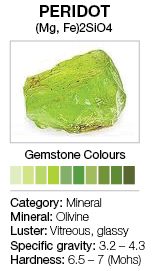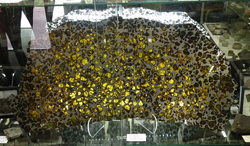 The Island of Serpents is a fitting name for the place where peridot the vibrant yellowy green gemstone was first discovered and mined around 1500 BC. Although peridot has been used for 4000 years, for centuries The Island of Serpents was the only known place in the world where peridot was found in quantity. In ancient times it was called the Island of Death, a legendary place ruled by the pharaohs and manned with soldiers. The penalty for landing on the island without permission was death. Today this place is called St. John’s Island, Topazios or Zabargad.
The Island of Serpents is a fitting name for the place where peridot the vibrant yellowy green gemstone was first discovered and mined around 1500 BC. Although peridot has been used for 4000 years, for centuries The Island of Serpents was the only known place in the world where peridot was found in quantity. In ancient times it was called the Island of Death, a legendary place ruled by the pharaohs and manned with soldiers. The penalty for landing on the island without permission was death. Today this place is called St. John’s Island, Topazios or Zabargad.
 Speaking of names…
Speaking of names…
St. John’s Island has had many names, so does the gemstone itself: peridot, olivine, forsterite and chrysolite. There is some confusion around how to pronounce peridot, per-i-doh or per-i-dot, both are correct. I prefer the former, a softer sounding word that gives the stone the esteem it deserves.
The origin of the name peridot is unclear. Before the 18th century peridot was known as topaz – an incorrect classification. The modern origin of the word comes from either pæderot which is Latin for a type or opal or the Arabic word faridat meaning gem.
Magma, meteors and Mars
This brilliant green gem is a volcanic crystal. Only 6.5 – 7 on th Mohs scale, it’s not a very hard stone but it is sturdy and relatively easy to care for. Peridot and diamonds are the only two gemstones that form below the earths crust. These stones reach the surface by means of a magma surge or “special delivery elevator” a term coined by the Smithsonian Institute.
Peridot is quite special, it’s the only gemstone found in meteors, they are rare Pallasite meteors. It’s also the first gem to be discovered on another planet – Mars in 2003. It turns out that the red planet is covered in about 19,000 square miles of green peridot crystals.
From Mars to Norway, most gem peridot is from Pakistan, Afghanistan and the U.S., but it’s also found and mined in Brazil, China, Hawaii, Mexico, Saudi Arabia, South Africa and Sri Lanka.

This exceptional and rare Pallasite meteor is in a class all its own. It contains chunks of Olivine, gemstone quality Peridot and Cat’s eye Peridot, embedded in a nickel-iron matrix. The original piece fell to earth weighing about 925 pounds in Fukang, Xinjiang Uygar
Only green
Throughout history its been mistaken for emeralds, and like the emerald peridot only occurs in tints of green, from brilliant to olive green. Some peridots occur in palest green that appears yellow. The highest valued stones are of the pistachio to dark olive variety. The tint and intensity of green depends on how much iron is in the crystal, the best coloured peridot contains traces of nickel and chromium.
Gem of the Sun
Peridot lights up spectacularly in the sun, this can be seen in the Fukang meteorite. It is said that the ancient Egyptians called peridot “the evening emerald” because after dusk they believed it glowed brilliant green in the desert and made it easy for the miners to note the location and return at day-break to collect them.





